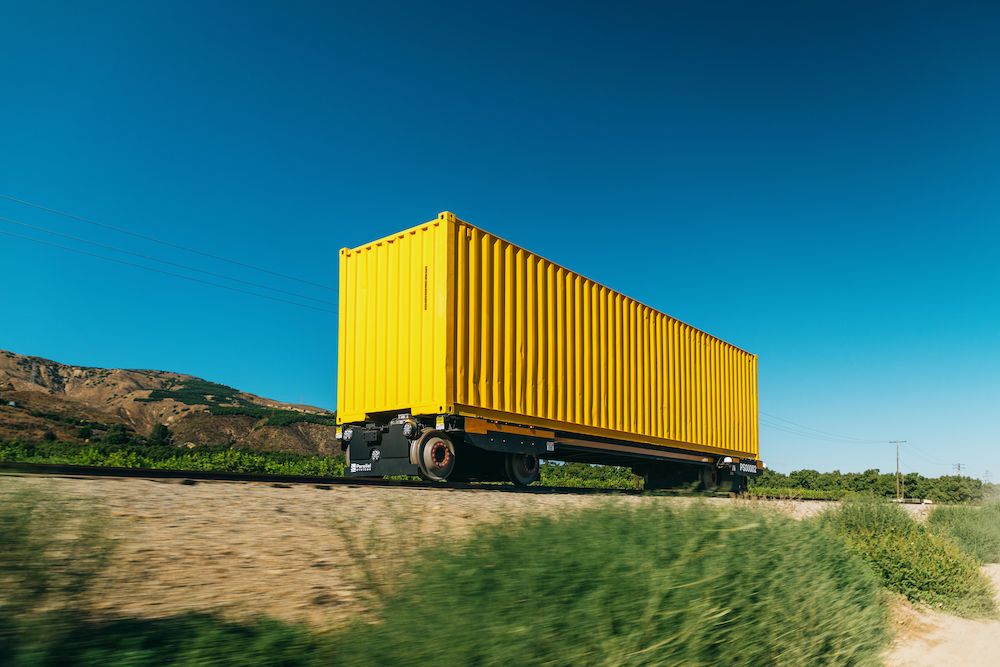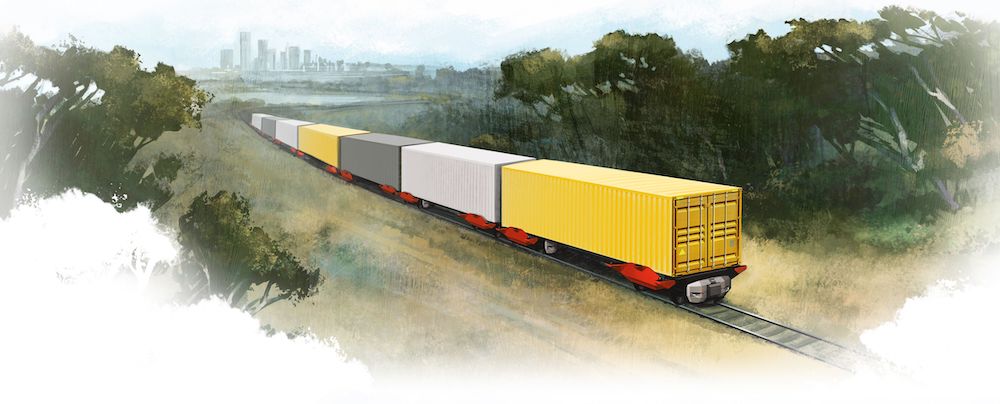
WASHINGTON — The Federal Railroad Administration is seeking public comments on Genesee & Wyoming short lines’ request to test Parallel Systems autonomous, self-propelled battery-electric freight cars.
The FRA, in a decision published in the Federal Register today, said it has accepted the Georgia Central Railway and Heart of Georgia Railroad petition for a test program and related temporary waivers of various safety regulations.
But the FRA will accept written public comments through March 18 and will schedule a public hearing. The safety agency also will conduct two separate reviews: One covering the requests for waivers of equipment regulations, and one covering the proposed test program.
“FRA will … address its evaluation of the test program in a separate decision after it completes its review of the requested waivers,” Chief Safety Officer John Karl Alexy wrote.
The Georgia Central and Heart of Georgia submitted their petition to the FRA on Aug. 10. Parallel’s cars, which lack couplers and use electronic brakes, are so unlike conventional rolling stock that the waiver petition asks the FRA to make the equipment temporarily exempt from car and locomotive regulations that cover everything from cabs and sanders to brake valves and uncoupling levers.
G&W’s 65-page document, titled “Application For Temporary Suspension Of Certain Rules And Exemption From Safety Appliance Standards For The Testing Of Novel Freight Rail Technology,” outlines the proposal for progressively more complex tests of Parallel Systems innovative equipment.
“The first priority of each phase of the Program is to assure safety of railroad employees, other persons and property, and the general public along the railroad lines that will be used for the Program,” according to the application.
Parallel’s cars — which can run alone or together as an autonomous platoon — can each carry a single 40-foot container weighing up to 65,000 pounds. They can operate at up to 25 mph and tackle grades as steep as 3%. “These design features are intended to help railroads better compete against trucks in the short-haul movement of intermodal containers rather than to replace conventional railroad rolling stock,” the application says.
The tests aim to evaluate the three primary components of the Parallel system: The autonomous vehicles themselves, the user terminals that allow people to control the equipment, and the computer servers that send data between the vehicles and the user terminals.
“FRA has conducted a preliminary review of Petitioner’s application to determine whether it meets the minimum regulatory requirements and provides enough information to be actionable by FRA, and FRA has found the application complete. However, upon analyzing the request, FRA has decided to treat Petitioners’ application as a request for waivers of compliance under the relevant provisions of 49 CFR part 211. FRA will also review Petitioners’ request for a test program under 49 CFR 211.51,” the FRA said in its decision.
Anyone wishing to provide written comments on the waiver and test proposal, Docket Number FRA-2023-0066, can submit them at www.regulations.gov and follow the online instructions for submitting comments.
Spokespeople for G&W and Parallel said the FRA’s decision was an expected step in the regulatory review process.















Gimmie another margarita while I think this over.
Back in the early 70s, my railroad telecom boss would sometimes send me to assist our line gang in a telephone cable replacement project near Newark, NJ, on the former D.L.&W. electric commuter line, where approaching electric M.U.s. were exceptionally quiet compared to diesel trains, so someone was always assigned as a watch person along the RoW to blow a whistle when an oncoming electric M.U. was approaching. Of course that practice was also used with noisy diesel trains as well, but the watchman (flagman) had to be extra cautious with the electric M.U.s. as they were deadly quiet. That said, I can imagine just how dangerous this new “Rube Goldberg” freight car transfer could be.
If these cars need to cross a road, who or what sounds the horn?
If all the of crossings, electronic or crossbucks are documented via GPS, then the car would know when to blow its horn.
Also using the a Ka band radar locator in the front of the transport, it will be able to slow down if it detects an obstruction at the coordinates.
Ka band is a very common collision avoidance system used by trucks, cars and buses for the last 15 years. Those who wonder what those little dimples are in the rear bumper of the SUV in front of you are looking at the sensors.
This ranks up there with other bad ideas like flying cars. Carnage along the rights
of way and in the yards. This should be tested in Pueblo first !
I have no problem evaluating and testing. If it fails, it fails and we document what was good, bad and ugly about the proposal and move on. That is how we learn.
IIRC…,Several years back, the European’s [possibly British or Germans?] seemed to be playing around with;l at that time,3 was was a concept of a small ‘train’ (A [MANNED] POWER UNIT That would pull one or two piggy-back, styled cars, as an ‘as needed’ service to certain locations(?) . Never seemed to get off the ground?
In this case, it seems to to be a calamity, awaiting to happen. With
current E V’s being prone to cold weather,related issues, they might consider a hybrid-type power source(?) to enable movement. Just my thoughts.
Railroads will go to any lengths to put hard-working men and women out of a job and jeopardize the safety of the public. In spite of all the solemn verbiage from RR management, it’s clear that it’s all about profits first, safety last. Haven’t we learned anything from the devastating derailments and “accidents” of recent history? Train crews have shrunk from four or more, to three, now two. And if the rail barons have their way, it would be one–or none! This utterly insane proposal should be stillborn.
Why wouldn’t an initial operational test like this take place @ Pueblo. Since it will require a new set of operating rules or a modification at a minimum, I would think they would want to perform a smoke test first where it wouldn’t be in public.
Good Point, John. PS is interviewing but apparently, at this point, failed to find a qualified Grant Writer. To quote famous American “Who Pays?”
Congratulations a system has been created that neutralizes all the benefits of moving freight on a train. Not to mention the additional risks to the public and track workers like myself.
How would this be able to compete with autonomous trucks?
I have a comment for the FRA. If these autonomous railcars have the same issues that autonomous automobiles have (like I don’t know…CRASHING INTO EACH OTHER), then the technology is “not ready for prime time”.
And I’m sorry, but no computer program can take into consideration how to respond to just about any situation. There WILL be situations that occur which have NOT been programmed into the autonomous vehicle’s computers. Responses for those situations require the best computer of all – the human mind. And I speak as a person with almost 45 years experience in I.T.
Lots of serious questions to be answered but it’s good to see some out-of-the-box thinking.
This has an “hyperloop” vibe to it: a solution in search of a problem, which will eventually proove impractical, uneconomical, if not outright dangerous.
These things do not belong on a mainline. At most, they should be restricted at moving within an enclosed terminal.
So does each unit get a track warrant and is programmed to only run from point A to point B? If point B is a siding, does someone have to come out and reprogram it for Point C? What happens if the battery fails mid-route? It can’t be rescued by the daily local.
If these cars are going to cross public roads and/or sidewalks, I can imagine people/children in the path of the car. How do these cars prevent fatalities?
Of course there are questions now before they are put in service. A big one is how do you move the things out of the way when they inevitably break down? How do you handle grade crossings. particularly those on lightly used lines where there may not be lights or gates? Who lines the switches for them where they are hand thrown? Does the whole shortline come to a screeching halt when they are on the line, or can other trains run as well? If so, how do you handle right of way issues, and how does the other train know where these things are? I am assuming these will have some sort of PTC. What happens when contact is lost with the PTC system or whoever is controlling them? These basic questions are in addition to the technical ones bound to pop up when they are actually in service.
The FRA wants public comment? What’s to comment on at the current time. Good Grief, get the concept out on the railroads to test and then perhaps there will be something to comment on.
Of course there are questions now before they are put in service. A big one is how do you move the things out of the way when they inevitably break down? How do you handle grade crossings. particularly those on lightly used lines where there may not be lights or gates? Who lines the switches for them where they are hand thrown? Does the whole shortline come to a screeching halt when they are on the line, or can other trains run as well? If so, how do you handle right of way issues, and how does the other train know where these things are? I am assuming these will have some sort of PTC. What happens when contact is lost with the PTC system or whoever is controlling them? These basic questions are in addition to the technical ones bound to pop up when they are actually in service.
It would seem like this would fall under on track equipment regulations rather than train movement. I’m going to assume some sort of track protection would be required along with stop distance tests. And where is the 360° beacon?